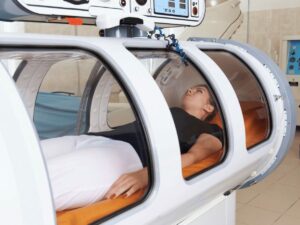Ever aware of the risks associated with hyperbaric chamber for some patients? Hyperbaric chamber contraindications are critical safety tips every operator should know.
As a seasoned expert in hyperbaric technology, I provide insights rooted in industry experience and the latest research.
Understanding these contraindications ensures not only the safety of users but also enhances the therapeutic outcomes of hyperbaric sessions. It’s about making informed choices.
In this guide, I will share the essential contraindications of hyperbaric chambers, from medical conditions to risk factors, ensuring practice’s safety and compliance.
Keep reading to safeguard your operations and enhance patient care!
1. Understanding Contraindications for Hyperbaric Chamber
Contraindications for hyperbaric chambers highlight scenarios where it’s unsafe to use these devices. Identifying these situations is critical to prevent complications and ensure the safety of all individuals involved. Health conditions or environmental factors that pose risks need careful management. Operators of these chambers must stay vigilant, as understanding these risks is essential for maintaining safety and effectiveness.
Misjudging these risks can lead to serious health issues and compromise the safety of the procedure. I believe it’s imperative for operators to be well-informed and proactive in managing these risks, which support the health of users and upholds the integrity of the treatment.

2. Absolute Contraindications
In the defining contraindications in the context of hyperbaric chamber section, it established clear parameters for safe treatment practices. Here are the non-negotiables, where the risks definitively outweigh potential benefits:
Untreated Pneumothorax
This condition involves air or gas trapped in the pleural cavity, the space surrounding the lungs, leading to potentially collapsed lungs. Hyperbaric chamber increases the risk of further air expansion, which can exacerbate the collapse, causing severe respiratory distress or even critical health emergencies.
Certain Types of Chemotherapy Drugs
Patients undergoing treatment with drugs such as doxorubicin or cisplatin should not enter to hyperbaric chamber. According to National Library of Medicine, it is advisable to stop administration at least 24 hours. These chemotherapy agents can become toxically potent when exposed to the high oxygen levels in a hyperbaric environment, posing serious risks like heart or kidney damage.
Severe Pulmonary Disease
Individuals suffering from severe lung conditions, including emphysema, may experience worsening symptoms inside the hyperbaric chamber. The high concentrations of oxygen used in treatments can lead to oxygen toxicity, which in severe cases might cause irreversible lung damage, acute respiratory distress, or other critical conditions.
Recent Ear Surgery or Trauma
Here’s the interesting part, hyperbaric chamber necessitates equalizing pressure throughout the body, and any recent surgical procedures or injuries affecting the ears can seriously impede this process. This impairment can lead to severe pain, significant disorientation, and potentially permanent damage to hearing capabilities, making careful screening for such conditions is essential before commencing treatment.
3. Relative Contraindications
Following the discussion of absolute contraindications, it is essential to consider relative contraindications. Here are conditions that require careful evaluation before proceeding:
Low Threshold for Seizures
Individuals with a history of seizures, particularly those not well-controlled by medication, present a nuanced risk. The increased oxygen levels can sometimes provoke seizure activity, necessitating a thorough medical review and possibly adjusted treatment protocols.
History of Thoracic Surgery
Patients who have undergone recent thoracic surgery may be at increased risk when exposed to the high-pressure environment in hyperbaric chamber. The stress on healing tissues and the potential for air trapping in surgical cavities make careful patient assessment essential before treatment.
Pregnancy
Here’s why this important to note, while there is no direct evidence suggesting hyperbaric chamber is harmful to fetal development, the lack of comprehensive research advises caution. Pregnant patients should only consider under circumstances where the potential benefits significantly outweigh the risks, and always in consultation with a healthcare provider specialized in maternal-fetal medicine.

4. Condition-Specific Considerations for Hyperbaric Chamber
After exploring relative contraindications, it’s crucial to discuss special considerations that ensure optimal safety and effectiveness. Here are the condition-specific considerations for hyperbaric chamber:
Cardiac Concerns
- Recent Myocardial Infarction: After a recent myocardial infarction requires careful timing. The increased oxygen levels can aid in healing the heart tissue, but early intervention risks exacerbating the condition by increasing oxidative stress.
- Uncontrolled Heart Failure: For patients with uncontrolled heart failure, getting into the chamber increases cardiac output demands, potentially leading to worsening heart failure or acute pulmonary edema.
Neurological Implications
- History of Seizures: While hyperbaric chamber is safe, it can increase the risk of seizure in individuals with a history of epilepsy. The elevated partial pressures of oxygen experienced during sessions can act as a trigger.
Diabetes
- The Risk of Hypoglycemia: Diabetic patients need to be vigilant about their blood sugar levels. The therapy can alter insulin requirements and increase the risk of hypoglycemia, especially if meals are skipped.
5. Risks of Ignoring Contraindications
Following our discussion on special considerations for hyperbaric chambers, it’s clear that these guidelines are vital for safe operation. Here are the significant risks associated with ignoring these contraindications:
Increased Risk of Medical Complications
Ignoring contraindications can lead to severe medical complications. For example, patients with untreated pneumothorax can experience a worsened collapse of the lung under increased pressure, potentially leading to life-threatening conditions. Ensuring all contraindications are considered is essential to prevent such critical outcomes.
Legal and Financial Repercussions
Facilities that disregard contraindications might face legal challenges, including lawsuits for negligence. For example, if a hospital administers a medication to a patient despite knowing that it conflicts with their medical history and the patient experiences severe adverse effects, they could face legal action. Compliance with all medical guidelines protects against such risks and upholds the standard of care.
Compromised Patient Safety
Here’s the most crucial part, the safety of patients and overlooking contraindications can threaten this. Without adhering to established safety norms, patient well-being is at risk, which can lead to adverse events, affecting health outcomes and patient trust in treatments. It is also advisable to choose quality chambers like Oxygen-Ark. Ensuring components are in top condition helps maintain the integrity of the environment.
6. Strategies for Handling Relative Contraindications
Understanding the risks of ignoring contraindications underscores the need for careful management of relative contraindications. Moving forward, let us talk now about the targeted strategies to effectively handle these situations:
Pre-Treatment Medical Review
Before using hyperbaric chamber, perform a detailed review of the patient’s medical records. This should focus on identifying any conditions that might interact negatively with hyperbaric conditions, such as a history of middle ear problems or mild COPD. This initial screening helps to customize protocols to individual needs.
Dynamic Treatment Adjustment
When patient is inside the chamber, they monitor closely to detect signs of discomfort or adverse effects. It is necessary to check first if the chamber is good quality, just like the offering from Oxygen-Ark, so that adjustments when needed may include and modify the oxygen concentration, based on real-time physiological responses.
Expert Consultations
For patients with conditions like diabetes, involve specialists in cardiology or endocrinology to develop a safe treatment plan. This multidisciplinary approach ensures all potential health impacts are considered before entering to the hyperbaric chamber.
| Specialty |
Role in Treatment Plan |
Expertise |
| Endocrinology |
Assess and manage diabetes-related metabolic issues |
Specialized knowledge in diabetes management |
| Cardiology |
Evaluate cardiovascular health and risk factors |
Expertise in heart conditions and their management |
| Hyperbaric Medicine |
Administer hyperbaric oxygen therapy (HBOT) |
Specialized training in hyperbaric medicine and oxygen therapy |
| Podiatry |
Address foot complications and wound care |
Specialized knowledge in diabetic foot care |
| Internal Medicine |
Coordinate overall medical care and monitor progress |
Broad understanding of medical conditions and treatments |
Dive Deeper Into Our Resources
For some insightful reads, we’ve curated a list of recommended articles just for you:
Still haven’t found what you’re looking for? Don’t hesitate to contact us. We’re available around the clock to assist you.
Conclusion
Understanding hyperbaric chamber contraindications is important for ensuring both the safety of patients and the efficacy of treatments. By implementing targeted strategies, facilities can maintain integrity, enhance outcomes, and foster trust.
For those looking for high-quality hyperbaric chambers, Oxygen-Ark stands out as a leading manufacturer. Their dedication to safety and customer support make them a preferred choice. Contact us today!


